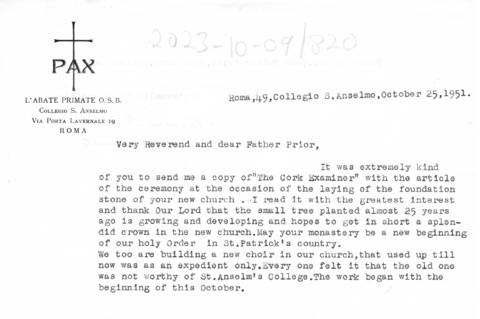Código de referencia
Título
Fecha(s)
- 25-10-1951 (Creación)
Nivel de descripción
Volumen y soporte
One A5
Nombre del productor
Nombre del productor
Historia biográfica
Josef Martin Kälin was born in Einsiedeln, Switzerland, on 22 March 1887. His parents were Josef Martin & Anna Verena (née Schön) Kälin. His father was a timber merchant and the family sought to educate all their children. From 1899 to 1907 he attended the high school located at Einsiedeln Abbey. He then entered the monastic life at Muri-Gries Abbey in northern Italy in 1908 and made his religious profession on 5 October 1909 being given the name "Bernard." He continued his education in the fields of Philosophy and Theology at the University of Freiburg and was ordained a Roman Catholic priest on 18 October 1912. He continued his studies at the same university receiving a doctorate in philosophy in 1918 with a dissertation on the Epistemology of Saint Augustine entitled "Die Erkenntnislehre des hl. Augustinus." Between the years 1913-1945 Kälin taught at Kantonsschule Obwalden overseen by the Benedictines, serving as teacher and rector of the school. During this time, he wrote a number of philosophy textbooks that became popular.
On 10 August 1945 Kälin was elected as the Abbot of Muri-Gries Abbey and received his blessing on 13 August 1945. He served in the role for only two years until he was elected as the third Abbot Primate of the Benedictine Confederation and Order of St. Benedict on 16 September 1947. As Abbot Primate he resided in Rome, Italy, while also overseeing Sant'Anselmo all'Aventino. He traveled quite extensively in his role as Abbot Primate, but was also instrumental in his work at the Pontificio Ateneo Sant'Anselmo where he founded a monastic institute, taught philosophy, and redesigned the Church of Sant'Anselmo. He served in this role until 1959 when he was not reelected as Abbot Primate, at which point he returned to Muri-Gries Abbey where he died on 20 October 1962.
Institución archivística
Historia archivística
Origen del ingreso o transferencia
Alcance y contenido
...

